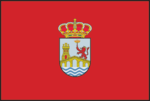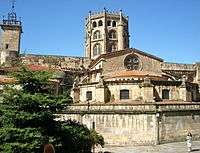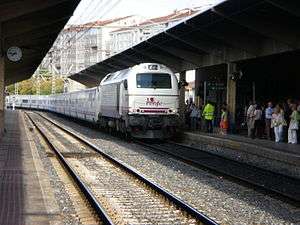Ourense
Ourense (/oʊˈrɛnseɪ/ oh-REN-say, Galician: [owˈɾɛnsɪ]; Spanish: Orense [oˈɾense]) is a city and capital of the homonymous province located in the autonomous community of Galicia, northwestern Spain. It is on the Portuguese Way path of the Road of St James (Camino de Santiago), and is crossed by the Miño, Barbaña, Loña and Barbañica rivers. It is also known as A cidade das Burgas[3] (in Galician) due to its hot springs, being one of the European cities with the greatest thermal heritage.[4]
Ourense Orense | |
|---|---|
.jpg) View of the Roman bridge Ponte Vella, in Ourense that traverses the Miño river | |
 Flag  Coat of arms | |
 Ourense Location of Ourense within Spain | |
| Coordinates: 42°20′11″N 7°51′48″W | |
| Country | Spain |
| Autonomous Community | Galicia |
| Province | Ourense |
| Comarca | Ourense |
| Government | |
| • Type | Mayor-council government |
| • Body | Concello de Ourense |
| • Mayor | Gonzalo Pérez Jacome (DO) |
| Area | |
| • Total | 84.5 km2 (32.6 sq mi) |
| Elevation | 132 m (433 ft) |
| Population (2018)[2] | |
| • Total | 105.233 |
| Demonym(s) | ourensán/ourensao (m), ourensá (f) ourensano (m), ourensana (f) |
| Time zone | CET (GMT +1) |
| • Summer (DST) | CEST (GMT +2) |
| Postcode | 32001 - 32005 |
| Area code(s) | +34 988 |
| ISO 3166-2 | ES-OU |
| Website | www |
Population
Its population of 105,233 (2019) accounts for 34.2% of the population of the province and makes it the third largest city of Galicia [5].
In 2019 there were 14,171 foreigners living in the city, representing 13.5% of the total population. The main nationalities are Portuguese (31.8%), Venezuelans (11.2%) and Romanians (7.9%).[6]
By language, according to 2018 data, 32.3% of the population always speak in Galician, 17.1% always speak in Spanish and the rest use both interchangeably.[7]
History
The origin of the town can be traced to the Romans and the presence of hot springs called the Burgas. These can still be seen today. There was also the need to fortify the place to protect one of the easiest ways to cross the Miño River. After the Romans, Ourense was part of the Suebi (Suevi) kingdom during most of the 5th, 6th and 7th centuries and was destroyed by the Moors in 716. It was later rebuilt by Alfonso III of Asturias about 877. The Norse invasions as well as attacks from the Arab warlord Al-Mansur once more laid the city to waste. It was only under Sancho II and his sister Doña Elvira that the city was resettled during the 11th century. The definitive urban impulse did not arrive until the 12th century when Ourense became an important center of services. Recently the city has made many efforts to provide new parks, bridges, fountains and geothermal springs installations to make the city more attractive.
Geography and geothermal springs
The ancient city of Auria[8] is located on both banks of the Miño river in the south-central part of Galicia, at an elevation of 128 meters above sea level.
Four rivers cross the town: Miño (the main river), Barbaña, Loña and Barbañica. The biggest river divides a rather industrial western suburb, which contains the railroad station, from the main town. Three highway and one railroad bridge cross the river in addition to the famous Roman bridge, Ponte Vella, which is now closed to vehicle traffic. The town is surrounded by forests, mainly oak and pine.
One of the main tourist attractions is related to hot springs, as Ourense holds one of the greatest amount of geothermal water in Europe, becoming one of the six founding cities of the European Association of Historic Thermal Cities in 2009. It is estimated that three million liters of hot springs flow every day throughout the province.[9] There are several places called pozas, burgas (galician terms) or termas (shared term between galician and spanish), with or without entrance fee, where you can have a bath outdoors. One of them (As Burgas) is located inside the old town centre, relating to the ancient Roman tradition, as ruins of a Roman bath were discovered and are now open to visitors.
There are more hot springs located along the river Miño:
- Termas da Chavasqueira. They are located near the fire station and the main entrance to the city, surrounded by green areas and the Miño river. Its waters flow at 63ºC and are bicarbonated, fluorinated, and sulfurized with medium mineralization.
- Fonte do Tinteiro. It's a manual traction fountain that expels low-mineralized, alkaline, sulphurous, fluorinated and mesothermal waters, located just 500 meters from the A Chavasqueira thermal area, at a 43ºC temperature.
- Pozas do Muíño da Veiga. They are located 3km from the city, next to an old renovated mill. The space has a large main hot spring of 200m2, a second of 130 m2 and two others of 55 and 45 meters respectively. Its waters flow at a temperature between 65ºC and 72ºC. As for its composition, they are low-mineralized, fluorinated, silicated and alkaline waters.
- Pozas de Outariz. They're near the Pozas do Muíño da Veiga, 4km from the city, and have two different parts separated by a pedestrian bridge that connects the OU-402 road with the enclosure: at the top are the Pozas de Outariz hot springs and at the bottom the Burgas de Canedo ones. The waters of this enclosure are low-mineralized, fluorinated, silicated and bicarbonated. The temperature at which these waters flow is 60ºC.
Climate
Ourense has a hot-summer mediterranean climate (Köppen climate classification: Csa).[10] Summers have hot daytime temperatures around 30 °C (86 °F), whilst winters are wet with daytime highs at 12 °C (54 °F) and lows a few degrees above freezing.[11] On August 3rd, 2018, Ourense recorded its hottest day on record at 42.7°C (108.9°F).[12] It is a microclimate generated by the unique orography of Ourense, affected by the Miño river valley, since the climate of Galicia is generally considered transitional oceanic or warm-summer mediterranean climate (Köppen climate classification: Csb).[13]
| Climate data for Ourense | |||||||||||||
|---|---|---|---|---|---|---|---|---|---|---|---|---|---|
| Month | Jan | Feb | Mar | Apr | May | Jun | Jul | Aug | Sep | Oct | Nov | Dec | Year |
| Record high °C (°F) | 22.0 (71.6) |
25.5 (77.9) |
30.6 (87.1) |
32.9 (91.2) |
37.6 (99.7) |
40.9 (105.6) |
42.6 (108.7) |
42.2 (108.0) |
41.2 (106.2) |
34.9 (94.8) |
26.3 (79.3) |
22.4 (72.3) |
42.6 (108.7) |
| Average high °C (°F) | 12.7 (54.9) |
15.1 (59.2) |
18.7 (65.7) |
19.8 (67.6) |
22.9 (73.2) |
27.5 (81.5) |
30.2 (86.4) |
30.6 (87.1) |
27.5 (81.5) |
21.7 (71.1) |
15.9 (60.6) |
12.8 (55.0) |
21.3 (70.3) |
| Daily mean °C (°F) | 8.0 (46.4) |
9.2 (48.6) |
11.9 (53.4) |
13.3 (55.9) |
16.2 (61.2) |
20.2 (68.4) |
22.5 (72.5) |
22.6 (72.7) |
19.9 (67.8) |
15.6 (60.1) |
11.1 (52.0) |
8.5 (47.3) |
14.9 (58.8) |
| Average low °C (°F) | 3.4 (38.1) |
3.2 (37.8) |
5.0 (41.0) |
6.7 (44.1) |
9.5 (49.1) |
12.8 (55.0) |
14.8 (58.6) |
14.5 (58.1) |
12.3 (54.1) |
9.6 (49.3) |
6.3 (43.3) |
4.1 (39.4) |
8.5 (47.3) |
| Record low °C (°F) | −7.0 (19.4) |
−6.6 (20.1) |
−6.8 (19.8) |
−3.2 (26.2) |
−0.4 (31.3) |
2.4 (36.3) |
6.4 (43.5) |
5.6 (42.1) |
3.0 (37.4) |
−2.0 (28.4) |
−6.8 (19.8) |
−8.6 (16.5) |
−8.6 (16.5) |
| Average precipitation mm (inches) | 89 (3.5) |
66 (2.6) |
59 (2.3) |
72 (2.8) |
64 (2.5) |
36 (1.4) |
20 (0.8) |
22 (0.9) |
57 (2.2) |
112 (4.4) |
103 (4.1) |
112 (4.4) |
811 (31.9) |
| Average precipitation days (≥ 1 mm) | 10.2 | 8.6 | 8.4 | 11.1 | 9.5 | 4.6 | 2.9 | 3.3 | 5.8 | 10.4 | 10.5 | 11.2 | 96.9 |
| Mean monthly sunshine hours | 87 | 115 | 166 | 180 | 205 | 249 | 278 | 268 | 204 | 138 | 84 | 70 | 2,054 |
| Source: Agencia Estatal de Meteorología[14] | |||||||||||||
Economy
The economy in the city of Ourense is marked by a predominance of service sector, the city has the largest shopping and leisure in the province, and administrative services (Xunta delegation, central and provincial government offices), educational (campus of the University of Vigo) and health (Ourense Hospital Complex) of reference. Construction industry is also important (Copasa, one of the biggest Galician construction companies, has its headquarters in the city).
The industrial area of San Cibrao das Viñas has many light industries including several important clothing factories, like Adolfo Dominguez and Roberto Verino, as well as automotive supplier industries.
Ourense is a well known producer of European chestnuts (Castanea sativa).
Coren, one of the Spanish agricultural sector's most important companies, has its headquarters in Ourense. The most read province newspaper is La Región.
Sights
Although mainly a town of services, Ourense is not without its tourist sites. The town has three parts: the medieval, the area of 19th-century expansion, and the modern perimeter. Many who pass by on the highway linking Madrid to Vigo are unaware of the medieval quarter, with its narrow streets and tiny plazas. Once an area of a certain dilapidated charm the area is now undergoing renovation and is full of typical restaurants and bars patronized by the university students of the town. The Plaza Mayor is the center of city life with its arcaded shops and the Town Hall.
The Cathedral is the most important monument in Ourense. This cathedral (founded 572; rebuilt in the 13th century) is the second oldest in Galicia. It occupies the same site as the Suevian basilica that stood there in earlier times. Romanesque in structure, but with a mixture of Romanesque and Gothic styles, it is rather hidden away but, contains a façade with the Door of Paradise in imitation of the Door of Glory of the Cathedral of Santiago de Compostela. Inside, the Capilla del Cristo, or Christ's Chapel (16th century), contains a crucifix venerated throughout Galicia.
The Miño is crossed at Ourense by the Ponte Vella (Old Bridge). With Roman foundations, it was reconstructed by Bishop Lorenzo in 1230 but frequently repaired since then; it has seven arches and a central span of 141 feet (43 m).[15]
La Ruta de la Plata (the silver route in English) and the Portuguese Way, different routes on the Camino de Santiago, both pass directly through Ourense.[16][17][18] La Ruta de la Plata, the longest of all the Camino's routes, begins in Sevilla and moves north though the west of the country.[17] The pilgrims on both routes are important to Ourense's tourism industry, especially in holy years of St. James when traffic on the Camino is especially high.[19]
Politics
| Party/List | 1979 | 1983 | 1987[20] | 1991[20] | 1995[20] | 1999[20] | 2003[20] | 2007[20] | 2011[21] | 2015[22] | 2019[23] |
| AP / PP | 5 | 11 | 11 | 12 | 14 | 14 | 14 | 13 | 11 | 10 | 7 |
| BN-PG / BNG | 2 | - | - | 2 | 6 | 7 | 7 | 6 | 3 | - | 2 |
| PSdeG-PSOE | 5 | 10 | 10 | 10 | 7 | 6 | 6 | 8 | 11 | 6 | 9 |
| DO | 2 | 8 | 7 | ||||||||
| Citizens | 2 | ||||||||||
| Ourense in Common | 3 | ||||||||||
| CG / CPG | 4 | - | |||||||||
| IDEGA | 3 | ||||||||||
| UCD / CDS | 9 | ||||||||||
| PCG / EU | 2 | - | - | - | - | - | - | - | - | ||
| Independents | 2 | ||||||||||
| Total | 25 | 25 | 27 | 27 | 27 | 27 | 27 | 27 | 27 | 27 | 27 |
Transport
The city is served by the Ourense Railway Station.
Barallete
Barallete was the name of an argot employed by the traditional knife-sharpeners and umbrella makers (afiadores e paragüeiros) of Ourense. It was based on the Galician language as spoken in Ourense, but its users substituted everyday words with invented ones of no linguistic connection, making it impossible for other people to understand it.
Notable residents
- Antonia Ferrín Moreiras, mathematician, professor, and the first Galician woman astronomer, was born in Ourense. [24]
Images
 Main square
Main square_01.jpg) María Auxiliadora Collegiate Church
María Auxiliadora Collegiate Church
References
- "IGE. Táboas". Ige.eu (in Galician). Retrieved 2017-10-11.
- Municipal Register of Spain 2018. National Statistics Institute.
- "As Burgas: Termas con historia". Turismo de Ourense (in Spanish). Retrieved 2020-04-27.
- "Ourense, la segunda ciudad termal de Europa". viajar.elperiodico.com (in Spanish). 2017-01-12. Retrieved 2020-04-27.
- "IGE. Táboas 2019". INE (in Spanish). Retrieved 2020-03-08.
- "IGE. Táboas 2019". Ige.eu. Retrieved 2020-03-08.
- "IGE. Táboas 2018". Ige.eu. Retrieved 2020-03-08.
- "Auria is the oldest name in Ourense, which perhaps survives in Oira" (Universal Galician Encyclopedia, s.v. "Auria"). Several historical publications published in Ourense have been designated with the name "Auria": a fortnightly magazine (1944-1946), a monthly one (March 1997) and a cultural supplement of the newspaper Faro de Ourense (November 1983). Finally, it is also a literary name of the city used by Eduardo Blanco Amor in his novels A esmorga and La Catedral y el niño.
- "Ourense, la segunda ciudad termal de Europa". viajar.elperiodico.com (in Spanish). 2017-01-12. Retrieved 2020-04-27.
- "Ourense, Spain Climate Summary". Weatherbase.com. Retrieved 22 July 2015.
- "Standard climate values for Ourense". Aemet.es. Retrieved 22 July 2015.
- Iglesias, Brais. "Ourense alcanza por primera vez los 42,7 grados, récord histórico". Laregion.es. La Region. Retrieved 21 August 2018.
- "Climate Galicia: Temperature, climate graph, Climate table for Galicia - Climate-Data.org". en.climate-data.org. Retrieved 2020-04-27.
- "Standard climate values. Ourense". AEMet. Retrieved 2020-06-13.
- Ponte Vella at Structurae
- "The Camino Portugués". Csj.org. Confraternity of Saint James. Retrieved 21 August 2018.
- "Via de la Plata". Santiago-compostela.net. Retrieved 21 August 2018.
- Gay, Gonzalo. "La Ruta de la Plata "es especial"". Laregion.es. La Region. Retrieved 21 August 2018.
- HERNÁNDEZ, IMANOL. "Más peregrinos para la Ruta de la Plata en este Xacobeo". Laregion.es. La Region. Retrieved 21 August 2018.
- "Consulta de resultados electorales. Ministerio del Interior". Infoelectoral.mir.es. Retrieved 2 February 2019.
- "Elecciones Locales 2011". Elecciones.mir.es. Retrieved 2 February 2019.
- "Elecciones Locales 2015". Elecciones.mir.es. Retrieved 2 February 2019.
- "Resultados Elecciones municipales 2019 en Ourense". La Vanguardia. 2019-05-26. Retrieved 2020-03-08.
- "Antonia Ferrín Moreiras. La primera astrónoma gallega". Revista.iaa.es (in Spanish). Retrieved June 28, 2016.
External links
| Wikimedia Commons has media related to Ourense. |
- Concello de Ourense (In Galician)
- La Región, Ourense's local newspaper founded in 1910
- Galicia Turismo: Turgalicia
- Ourenet: Buscador da la Provincia de Ourense
- Map of Ourense by MapQuest
- General information, images, forums and more
- Photographs of Ourense
auto

